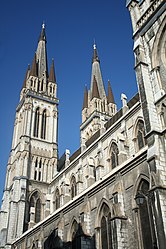Voiron
Voiron
Commune in Auvergne-Rhône-Alpes, France
Voiron (French pronunciation: [vwaʁɔ̃]; Arpitan: Vouèron) is a commune (French municipality) in the ninth district of the Isère department in southeastern France.[3] It is the capital of the canton of Voiron and has been part of the Grenoble-Alpes Métropole since 2010. Voiron is located 25 km (16 mi) northwest of Grenoble and 85 km (53 mi) southeast of Lyon. Its roughly 20,000 inhabitants are named Voironnais in French.
This article has multiple issues. Please help improve it or discuss these issues on the talk page. (Learn how and when to remove these template messages)
|
Voiron, along with Chambéry and Grenoble, is a gateway city of the Chartreuse Mountains in the Auvergne-Rhône-Alpes region.





